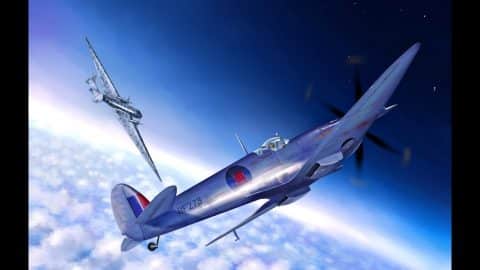
YouTube / Mark Felton Productions
The Junkers Ju 86 is an aircraft that most people aren’t that familiar with. However, this warbird would play a very interesting role in WWII as part of the highest-altitude aerial battle in the history of the war – one that happened over 8 miles above the earth.
The Ju 86 was ushered into service as a bomber, even though it was also designed as a commercial airliner. To nobody’s surprise, the bomber performed very poorly at the start of the Spanish Civil War.
Regardless, the Luftwaffe used the Ju 86 since the start of WWII, converting some airframes to the “P” variant, with a longer wingspan, a pressurized cabin, two crew members, and a Junkers Jumo 207 turbocharged two-stroke opposed-piston diesel engines. More importantly, it was designed to fly comfortably at 39,000 ft and could go higher for photoreconnaissance missions.

Two versions of the P variant were made: The P-1 high-altitude bomber, and the P-2 photoreconnaissance aircraft.
Its next variant, the Ju 86 R-1, was also a high-altitude recon plane capable of cruising along at 50,000 ft – significantly higher than most commercial jet airliners cruise today. In a way, the Ju 86 was the U-2 spy plane of its day.
At the time, the Spitfire Mk. V lacked the legs to reach the Ju 86. However, the Mk. IX variant showed promise with its Rolls-Royce Merlin engine.
A special interception flight was created at RAF Croydon to stop the Ju 86 from wreaking more havoc. It was commanded by Flight Lieutenant Jimmy Nelson of the RAF’s Eagle Squadron, who prepared his pilots for a fight where two planes had never clashed before. As such, two Spitfires were carefully modified for the mission.
Both Spitfires had their weights reduced by 450 lbs, substituting the metal propeller for a wooden one and removing all four of its Browning machine guns.

On September 12, 1942, British radar detected an incoming raid flying at extreme altitudes heading for Portsmouth. The first Spitfire was scrambled from Northolt and began steadily climbing towards the Ju 86 at 40,000 ft.
After seeing the Spitfire climb closer toward the Ju 86, its crew released the bombs and injected nitrous oxide into the diesel engines to boost their power. They also depressurized the cabin, since one shot from the Spitfire would cause the entire cabin to explode.
In response, the Spitfire pilot dropped his external fuel tank and somehow climbed slightly higher than the Ju 86. The Spitfire started its attack from 200 yards behind the German plane, firing a short burst before its left cannon jammed.

This upset the aircraft’s balance which forced him to fly into the bomber’s contrail. Unfazed, the pilot regained control of the Spitfire and maneuvered for another shot at 44,000 ft. After three short bursts, the pilot was forced to break off the fight as he ran out of fuel.
Unfortunately, the Ju 86 would disappear over the English Channel and land safely in France with just one 20mm shell hole in the port wing. But ever since the British called their bluff, the Ju 86 never returned to British airspace ever again.